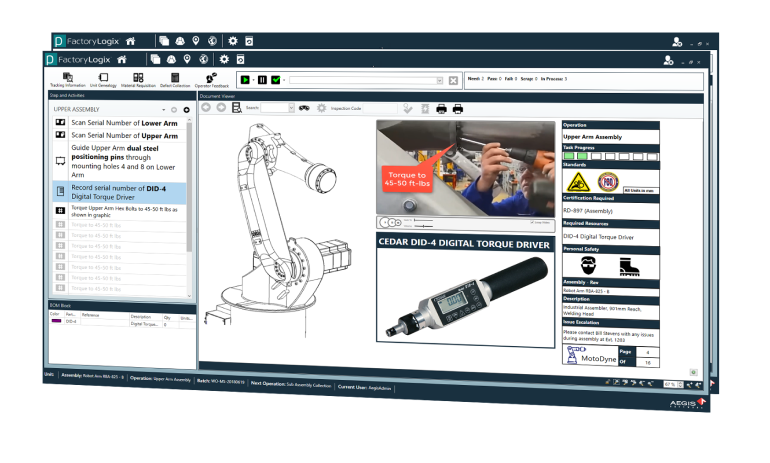Summary:
Manufacturing journalist Thomas R. Cutler interviews Aegis Software founder Jason Spera. Makers of
FactoryLogix, Spera shares the trends in factory floor automation including Industry 4.0-IIoT capabilities, which seamlessly connect assets and systems.
He also discusses a lower cost of ownership with a highly configurable, low-risk platform with cross-industry best practices based on more than 2,000 global customers.
The result of this automation is increased efficiency and competitiveness with guided and monitored NPI process across large multi-user groups keeping discrete manufacturers on schedule from launch to production.
Zero-Defect Quality is also discussed allowing projects to the highest standard knowing every resource is validated at each station. The role of automation in 2021 requires a fresh look at MES and MOM.
Jason Spera, picture left, recently shared his vantage of the changes for factory floor automation in 2021. Jason is CEO and Co-Founder,
Aegis Software. Spera is a leader in MES/MOM software platforms for discrete manufacturers with particular expertise in electronics manufacturing. Founded in 1997, today more than 2,200 factory sites worldwide use some form of Aegis software to improve productivity and quality while meeting regulatory, compliance and traceability challenges. Spera's background as a manufacturing engineer in an electronics manufacturing company and the needs he saw in that role led to the creation of the original software products and continue to inform the vision that drives Aegis solutions, like FactoryLogix. He regularly speaks on topics surrounding factory digitization, IIoT, and Industry 4.0.
Contact Jason on
LinkedIn.
TR Cutler:
How is factory floor automation changing in 2021?
Jason Spera: We still associate high volume products with very low or no customization. The goal of automation has been to lower costs and increase quality, but those goals have largely relied upon a predictable product configuration that changes very little. Humans are good at bespoke product production and terrible at consistent high-volume production, whereas robotics have traditionally been the converse.
TR Cutler: Is that paradigm changing-at least the robotics and automation part?
Jason Spera: Some believe COVID has caused a consumer shift from unhindered consumption of low-quality standardized product to increased interest in higher-quality personalized products. The consumer expects personalization options for products such as shoes, glasses, electronics, automated window coverings, and countless other items-but they have not diminished the expectation for speed of delivery, quality, or even cost.
Most manufacturers live in a state of constant change compounded by the hourly or daily crisis. These crises are often originating externally, not through any fault or business deficiency of the manufacturer.
TR Cutler: How does the "automate to order" mentality change the role of manufacturing?
Jason Spera: Automate to Order (ATO) involves another layer of complexity in real-time production flexibility to achieve single-piece product flow at high-volume efficiency. The new expectation of Automate to Order, where the parts are chosen by the consumer, must be physically modified to fulfill their requirement?it is not merely part swapping. It may involve cutting, bending, finishing, drilling, and other physical modifications to make the final assembly adding to manufacturing complexity. Achieving ATO in high efficiency production is a tremendous challenge.
Off-the-shelf manufacturing execution system (MES) and manufacturing operations management (MOM) are transforming the factory floor. Factory floor automation used to require heavily customized software overlaying the automation layer. It was the only way to achieve any efficiency. Now, this can be done with off-the-shelf MES/MOM.
TR Cutler: Why is this shift such an important development for factory floor automation?
Jason Spera: It extends the luxury of high-efficiency personalized production from the sole domain of giant manufacturers, with legions of in-house developers. Production control software nearly in real-time is accessible to any manufacturer. It effectively democratizes production personalization so any manufacturer can support it.
TR Cutler: What factory floor challenges are uniquely attributable to the FactoryLogix solution?
Jason Spera: There are many. From system consolidation to contextualized analytics, and a true digital thread and twin. Additionally, IIoT (Industrial Internet of Things) + MOM as well as depth of trace through the value chain are part of the unique value proposition.
TR Cutler: Aegis is well-known in the electronics industry. What lessons have been learned in electronics that are now being applied to other sectors?
Jason Spera: It is a matter of higher functional expectations demanded in a climate of greater cost consciousness that pervades electronics assembly. Consider traceability and quality depth differences when dealing with circuit cards that often have well over 1000 individual parts per card, each with hundreds of connections.
PCB manufacturers have long been pressed for delivering high-mix production at the efficiencies of static-high-volume production, while at the same time delivering greater depth of traceability and quality, despite having tighter profit margins than most upper-level product assemblers. This 'worst case convergence' of demand for constant product changeover and yet high volume, high quality, great data depth at low cost informed the development of everything about FactoryLogix. A system born to support even highly sophisticated mechanical assembly cannot traverse successfully into electronics, but one born from electronics finds the transition quite easy, as it is a matter of going from a more granular data model to a less granular-where the inverse is not possible.
 TR Cutler: Are you suggesting that discrete assembly suffers from low expectations regarding MES, but that will inevitably change?
Jason Spera
TR Cutler: Are you suggesting that discrete assembly suffers from low expectations regarding MES, but that will inevitably change?
Jason Spera: Yes. By offering a level of adaptability for high mix and personalized manufacturing (while delivering depth of control and data acquisition) we actually increase throughput. This is simply not something discrete manufacturers typically believe is possible, because they are accustomed to legacy approaches to MES. Those outside of electronics, often report 'We'd be happy simply with WIP visibility in production. This is a LOT more than we expected.'
TR Cutler: What automation failures or limitations can now be easily overcome?
Jason Spera: Most importantly there is now production flexibility in high volume, steady-state production management via a software platform. Most manufacturers live in a state of constant change compounded by the hourly or daily crisis. These crises are often originating externally, not through any fault or business deficiency of the manufacturer. Customers or engineering cause a sudden change and a part swap-out is required mid-production. Changes include a different configuration mid-run, from quantity to delivery date. Program managers call the factory demanding entire lines be reallocated for a 'displeased' customer. All of these realities are common, but most MES/MOM systems simply cannot adapt to such changes many times daily with any fluidity.
Thomas R. Cutler is the President and CEO of Fort Lauderdale, Florida-based, TR Cutler, Inc., celebrating its 22nd year. Cutler is the founder of the Manufacturing Media Consortium including more than 8000 journalists, editors, and economists writing about trends in manufacturing, industry, material handling, and process improvement. Cutler authors more than 1000 feature articles annually regarding the manufacturing sector. More than 4800 industry leaders follow Cutler on Twitter daily at @ThomasRCutler. Contact Cutler at trcutler@trcutlerinc.com.
See More Details.



